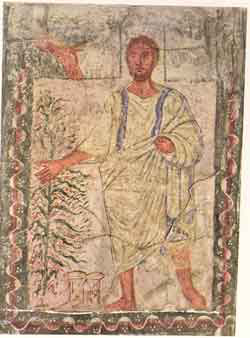Who is Elijah?
The prophet Elijah is one of the most well-known figures throughout all stages of Jewish literature, from the Bible, through the midrashic literature and Kabbalah, up to folk tales and modern Hebrew plays. Elijah has an important place in Christian and Moslem traditions as well.
The Biblical tales of the prophet Elijah (I Kings 17-19; 21; II Kings 1 - 2) present him as a “Man of God”: the recipient of special divine grace, endowed with supernatural powers, particularly the ability to instantaneously appear and disappear (I Kings 18: 7-15; II Kings 1). He performs miracles on several occasions; some before the multitudes, others in private settings. Amongst the former, he brings a drought upon the land of Israel and its environs (I Kings 17:1) and calls down fire from heaven upon his offering on Mt. Carmel (I Kings 18). Amongst the latter, he revives a foreign woman’s son (I Kings 17). Some of these acts appear to be performed on his own initiative and by his own power; others as the outcome of his prayer.
In all these instances, Elijah appears as a paragon of zealousness for the pure Israelite faith, permitting no synthesis or compromise with other cultures, particularly with the Canaanite-Phoenician culture. Elijah’s confrontations with Ahab, the king of Israel, are primarily focused on this religious conflict (I Kings 17; I Kings 18). Yet even in the incident of the vineyard of Naboth (I Kings 21), which centers on moral standards of the regime, the prophet stands before the king as an accuser and a zealot.
In II Kings 2, Elijah achieves a unique status when he ascends to the heavens in “a chariot of fire and horses of fire” and his servant-disciple Elisha receives his cloak as a sign of his status as Elijah’s successor.
The figure of Elijah also appears outside the collection of tales of his life and works in the Books of Kings. He is mentioned, for example, in the book of Malachi:
(כג) הִנֵּ֤ה אָנֹכִי֙ שֹׁלֵ֣חַ לָכֶ֔ם אֵ֖ת אֵלִיָּ֣ה הַנָּבִ֑יא לִפְנֵ֗י בּ֚וֹא י֣וֹם יְהֹוָ֔ה הַגָּד֖וֹל וְהַנּוֹרָֽא׃ (כד) וְהֵשִׁ֤יב לֵב־אָבוֹת֙ עַל־בָּנִ֔ים וְלֵ֥ב בָּנִ֖ים עַל־אֲבוֹתָ֑ם פֶּן־אָב֕וֹא וְהִכֵּיתִ֥י אֶת־הָאָ֖רֶץ חֵֽרֶם׃
(23) Lo, I will send the prophet Elijah to you before the coming of the awesome, fearful day of GOD. (24) He shall reconcile parents with children and children with their parents, so that, when I come, I do not strike the whole land with utter destruction.Lo, I will send the prophet Elijah to you before the coming of the awesome, fearful day of GOD.
These verses suggest an important role for Elijah in the time approaching “the day of the Lord”, usually understood as an element of the ideal epoch in the time to come.
Elijah in post-biblical Jewish tradition
Although a critical tone towards Elijah may be found in some rabbinic statements, generally Elijah has been perceived in Jewish tradition as a very positive figure, visiting the people of Israel throughout the generations, helping them in times of distress, revealing secrets to the sages of the Mishnah and the Talmud, and destined to herald the coming of the Messiah. This tendency comes through in the midrashic literature, in medieval Jewish exegesis, and in Jewish folklore, as well as in Christian and Muslim religious literature.
The midrashic literature’s treatment of Elijah focuses primarily on his role in the time to come. This role stems primarily from the tradition in Malachi 3, which views Elijah as the herald of the advent of the messiah. With the development of the messianic idea in the second Temple period, this tradition became dominant as Elijah’s primary role.
These messianic hopes appear to have engendered another important role for Elijah: the benefactor of the oppressed people of Israel wherever they may be. This role is particularly emphasized in Jewish folk tales. Another aspect of Elijah’s assistance can be found in his part in all circumcision ceremonies, which is again derived from a passage in Malachi 3 , mentioning “the angel of the covenant” (verse 1).
Elijah’s ascent to heaven (II Kings 2:1-12), surprisingly enough, gets very little treatment in the Midrash and exegesis, and there is a tendency to downplay this episode. Radak, for example, argues against the view of those exegetes who believed that Elijah entered paradise in his material body. Some midrashim compare Elijah’s ascent to Moses’s ascent, while other sources flatly deny Elijah’s ascent (and Moses’s as well). This reticence appears to stem from the concern about turning any human figure, however revered, into an object of worship.
Elijah in Jewish art
Jewish artistic treatment of Elijah is extant from the Talmudic period up to modern times; these works reflect both the general Jewish affinity for Elijah as well as the zeitgeists of specific eras. For example, amongst the frescoes in the synagogue in Dura Europos (244-256 C.E.), three scenes from the tales of Elijah survived intact, and there apparently were others that did not survive. One scene depicts the revival of the son of the Zarephite woman (I Kings 17:17-24).
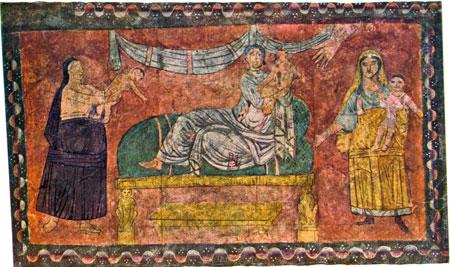
Dura Europos, Revival of the Zarephite's Son
In this scene, on the left, the widow gives Elijah her dead son. Note that the blurring of both their faces and the black garb of the widow signify mourning for the death of the child. In the center, Elijah holds the child and prepares to rise from the bed following his revival of the boy with the help of God, represented by the arm outstretched from above. On the right, the widow, now dressed in festive garb, holds her living child joyfully (and here the faces are depicted clearly).
The two other scenes preserved at Dura Europos depict the contest on Mt. Carmel. In one, the prophets of the Baal are standing around an altar on which is laid an offering with no fire.
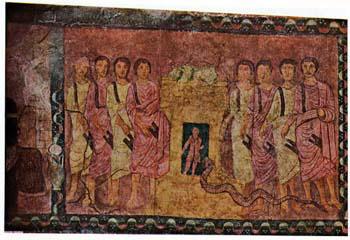
Dura Europos, The Failure of the Sacrifice to Baal
The distinctive feature of this scene is the small figure standing at the aperture in the bottom part of the altar, with a large snake about to bite him. This appears to be a pictorial expression of the Midrash that tells of an Israelite heretic who planned to kindle a flame under the offering of the prophets of Baal, but his scheme was foiled by the bite of a snake sent from heaven. The artist emphasized the helplessness of the prophets of Baal by standing them in parallel rows and by their flaccid hands.
The third scene at Dura Europos depicts people pouring water on the altar, according to Elijah’s instructions (vv. 34-35), on the right side, and on the left, Elijah’s success in calling down fire from heaven, despite the water.
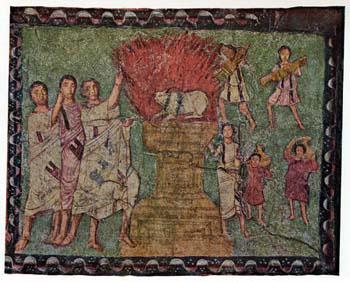
Dura Europos, Elijah's Sacrifice
Art historians believe these scenes express Elijah’s centrality in the messianic yearnings of the people of Israel for redemption from gentile oppression.
Elijah’s prominence in the Dura Europos frescoes can be understood in the context of the general trend of the murals in this Talmudic era synagogue: fervent hope for the redemption of the people of Israel from their oppressed condition and the return to the glory days, the life of the nation focused around the Temple, King David as messiah, the prophet Elijah as his herald.
The ideological nature of this approach becomes apparent when compared with Rembrandt’s approach, which emphasizes the drama of Elijah’s standing alone in opposition to a multitude:
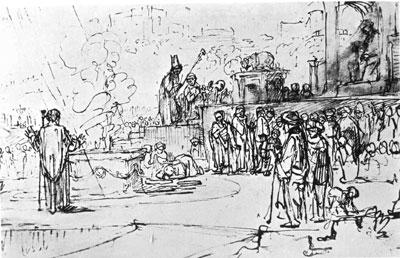
Rembrandt, The Judgment on Carmel, 1647
Traditional Jewish art, from medieval to modern times, mainly addresses Elijah’s role as messianic herald and spiritual godfather at circumcision rites. The figure of herald is depicted especially in Haggadot as illustration for the text of “Pour out Thy wrath upon the nations”.
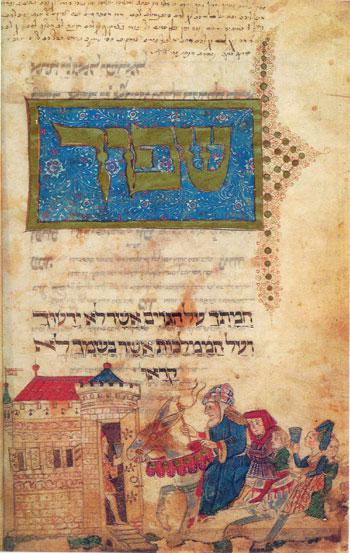
Yet the illustration itself does not reflect the open hostility towards the gentiles expressed in the text; rather it stresses the hope connected with the advent of the messiah. Elijah is depicted here riding an ass, with a Jewish family riding behind him. Modern Jewish artists have also depicted Elijah in this manner.
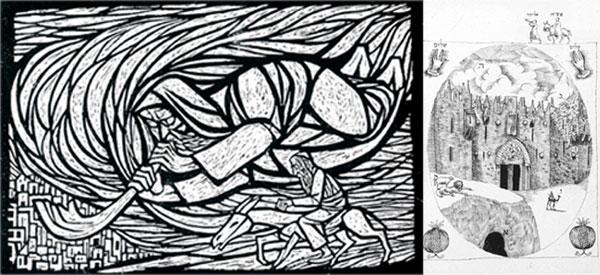
Sigmund Forst, Mark Podwal,
Entry of the Messiah into Jerusalem, 1965 Shalom, 1978
In the two examples shown above, Elijah is depicted blowing a shofar and accompanying the Messiah, riding his ass, with Jerusalem serving as the setting for the advent of the Messiah. On the left, illustrator Sigmund Forst uses thick bold lines, enlarging the figure of Elijah to super-human proportions, hovering in the sky over the suffering figure of the Messiah. Mark Podwal, in contrast, using fine lines and a rounded structure, creates a visionary appearance, reducing Elijah’s proportions and representing him as an escort walking before a noble Messiah; these small images are joined by additional miniature symbols such as a lion and a lamb (Isaiah 11), pomegranates and hands in a gesture of the blessing for peace. The primary element in Podwal’s illustration is the gates of Jerusalem, a secondary element for Forst. Thus, these two artists attribute divergent meanings to Elijah’s image as herald of the Messiah: Forst, a refugee from the Nazis, expresses the yearning for an end to the sorrows of Exile, while Podwal, in the 1970’s, looks forward to a future characterized by peace.
This same passage in the Passover Haggadah served as inspiration for Jewish artists who crafted Elijah’s Goblets’ expressing primarily a sense of majesty and splendor. This sense is also expressed in Elijah’s Thrones.
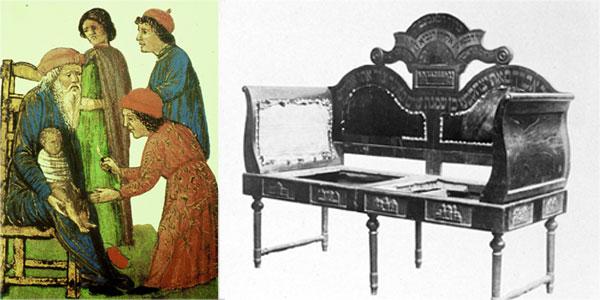
Rothschild Miscellany, Throne of Elijah,
Circumcision, 1470-1480 Palestine, Nineteenth Century
As mentioned, Elijah’s continual presence is connected to the tradition that the prophet did not die, but was taken alive to heaven. Thus, he visits Jews in all generations in times of trouble and danger as well as times of celebration, and continues to watch over Israel’s relations with God, by participating in the foundational ritual of Covenantal circumcision. This participation is expressed in the Thrones of Elijah shown above – on the left from the Rothschild Miscellany, created in Italy during the Renaissance, and on the right in a photograph of a Throne of Elijah constructed in the Land of Israel in the nineteenth century.
In the work of the modern Jewish artist, Marc Chagall, the image of Elijah, who watches over the Jews in every generation, merges with the image of the Wandering Jew:
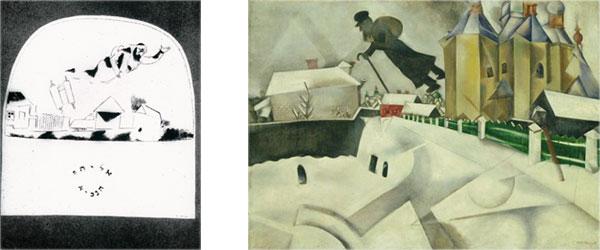
On the left, the figure with the sack and the staff hovering over the Jewish village Vitebsk is not identified; it passes over the snow-covered road from the direction of an impressive Russian church toward a large house, fenced off and shuttered (apparently a synagogue). In this manner, the artist emphasizes the vulnerable condition of the Jews in the time of his childhood, who, like him, were on the verge of becoming refugees. Thus it appears that the hovering figure is the Wandering Jew. In the picture on the right, the hovering figure waving its hand in blessing (not holding anything but accompanied by a Torah scroll), is identified as the prophet Elijah. In both cases, the image watches over the Jews from above, as in various Jewish traditions regarding Elijah.
Under the influence of the Christian artistic traditions that he encountered in Paris, Chagall also treated stories of Elijah which were not employed in Jewish art, such as his nourishment by an angel on the way to Horeb (I Kings 19) and his ascent to heaven (II Kings 2).
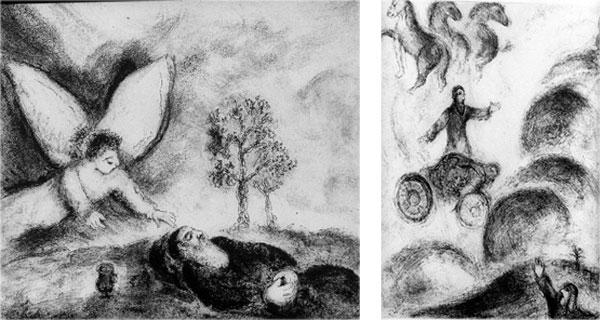
Marc Chagall,
Elijah in the Desert, 1931/1956 Chariot of Fire, 1956
Elijah in Christian and Muslim traditions
The biblical and midrashic figure of Elijah had great influence on both Christianity and Islam, but in very different ways.
From its origins in Judaism of the second Temple period, Christianity drew its fascination with Elijah’s role as herald of the Messiah. Several passages in the New Testament (John 1:19f) may reflect the belief that John the Baptist was actually an reincarnation of the prophet Elijah. Similarly, various episodes of Elijah’s life were interpreted as anticipations of the life of Jesus and were the subject of great interest and many artistic expressions. For example, the two stories of Elijah being fed from heaven in the wilderness (by ravens in I Kings 17: 3-7 and by an angel in I Kings 19:5-8)) were associated by Christian artists with Jesus’s sojourn in the wilderness.
The divine grace that the Man of God received particularly in the wilderness intrigued Christian artists in every generation.
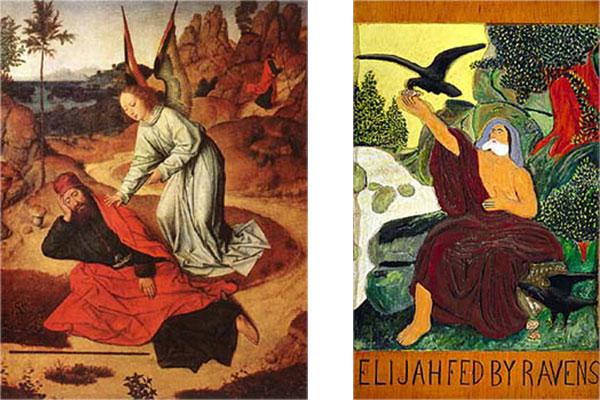
1464-1468 Nineteenth century
On the left, an unknown American painter from the nineteenth century depicted a robust Elijah being fed by ravens in a rather American looking countryside. On the right, Dieric Bouts imagined, in 1464, a very un-Dutch landscape as the background for Elijah’s feeding by the angel, a story understood in Christian tradition as anticipating the Eucharist, the central rite in Christian ritual, established by Jesus at his Last Supper.
Early Christianity also saw in the image of Elijah in these tales the prototype of the hermit, withdrawing to the wilderness to distance himself from the materialism of civilization.
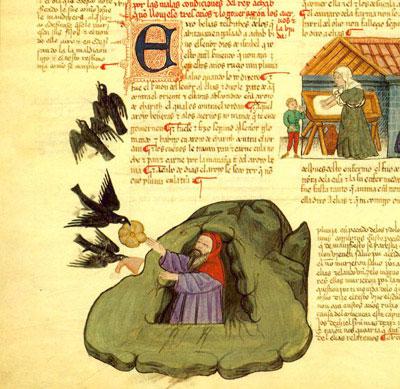
Alba Bible, Elijah fed by ravens/With the Zarephite Widow,
1430
In addition to these stories, Christian artists took great interest in the tale of Elijah being fed by the Zarephite widow (I Kings 17:10-16). Both this food miracle and that of the ravens (vv. 3-7) are depicted together on this illuminated page from the Bible of the Duke of Elba.
Several medieval depictions of the encounter with the Zarephite widow express the Christian understanding of the widow and her son as anticipating Saint Mary and Jesus.
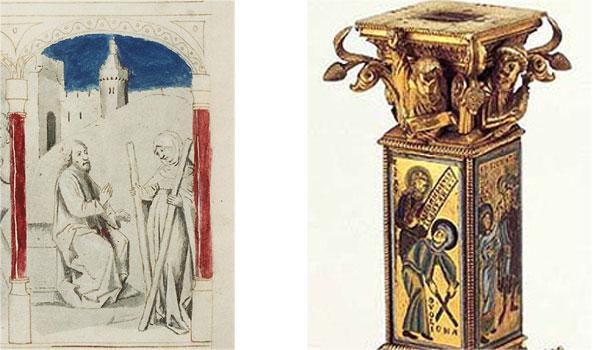
These artists apparently based their depiction of the story on St. Augustine's interpretation (Contra Faustum, XII, 34) of a passage from the story:
(יב) וַתֹּ֗אמֶר חַי־יְהֹוָ֤ה אֱלֹהֶ֙יךָ֙ אִם־יֶשׁ־לִ֣י מָע֔וֹג כִּ֣י אִם־מְלֹ֤א כַף־קֶ֙מַח֙ בַּכַּ֔ד וּמְעַט־שֶׁ֖מֶן בַּצַּפָּ֑חַת וְהִנְנִ֨י מְקֹשֶׁ֜שֶׁת שְׁנַ֣יִם עֵצִ֗ים וּבָ֙אתִי֙ וַעֲשִׂיתִ֙יהוּ֙ לִ֣י וְלִבְנִ֔י וַאֲכַלְנֻ֖הוּ וָמָֽתְנוּ׃
(12) “As the ETERNAL your God lives,” she replied, “I have nothing baked, nothing but a handful of flour in a jar and a little oil in a jug. I am just gathering a couple of sticks, so that I can go home and prepare it for me and my son; we shall eat it and then we shall die.”
According to Augustine, the "Old Testament" is alluding to the two wooden beams of Jesus' cross. Others emphasize the widow’s compassion or Elijah’s benevolence in the story of the miracle.
The revival of the widow’s son was also compared to the resurrection of Lazarus.
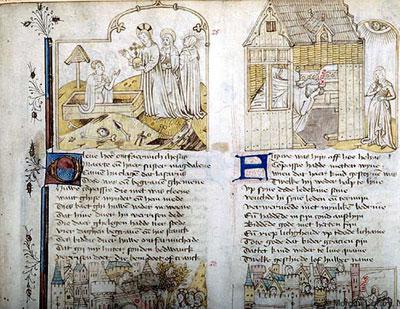
The story of Elijah’s ascent to heaven (II Kings 2:1-12) received frequent treatment by Christian artists. As we have seen, this story was the source of some discomfort amongst many Jews; for Christianity, however, this too was interpreted as a prefiguration, in this case of Jesus’s ascent to heaven after his death (Mark 16:14-19) and as an expression of resurrection in general. Accordingly, the story is depicted on the early Christian sarcophagus shown below, with the prophet standing in a chariot of fire, waving his cloak, while Elisha, his successor, stands below and to the left, watching in admiration.
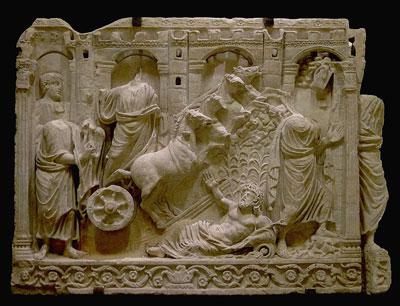
Late Fourth Century
In the Quran (37: 123 - 132), as well, Elijah appears as an anticipator, in this case of Mohammad. Here, however, the emphasis here is on his role as a prophet confronting a stiff-necked people, for which he gains divine favor. Additionally, the image of Elijah blends with the legendary figure of al-Hadr. Muslim exegesis identifies this saint as a figure in the Quran, who teaches Moses to “walk humbly”, and is characterized primarily by his ability to appear and disappear instantaneously and by his immortality. Thus, later oral and literary Muslim traditions blended the two figures together.
Elijah appears in Islamic art primarily in one scene rooted in the Quran (18:60f.) and elaborated in later Islamic legends.
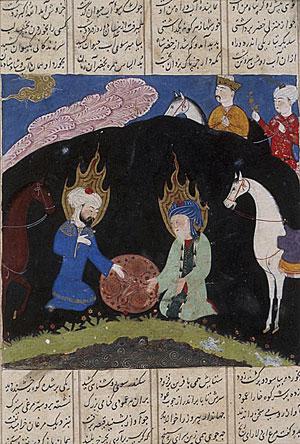
In this scene, Elijah and el-Khadr together discover the “Fountain of Life”. This tale has very complex roots in medieval Jewish, Muslim and Christian legends; the essence, though, is the belief that Elijah attained eternal life.
In sum, the figure of the prophet Elijah in artistic representations primarily reflects the belief that this “Man of God” attained immortal life and thus serves as a focus for hopes for redemption, both material and spiritual.
For additional images on this subject see TALI Visual Midrash



